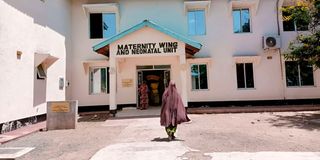Giving birth game of chance for mothers at Hola hospital

The maternity and neonatal wing at Hola County Referral Hospital in Tana River County.
Proud new mother Rukia Abdi considers herself lucky to be holding her baby in her arms. For a few harrowing hours at the Hola County Referral Hospital , it was touch-and-go for both mother and infant.
She had hoped to deliver her baby safely in a hygienic environment, where she would be handled with care.
But this was not to be. When the time came for her to deliver, the only functional delivery bed was occupied, forcing nurses to help her give birth on the floor.
“I initially resisted the idea but, because I was in pain and my water had broken, there was no time to argue. The nurses attended to me on the floor,” she says.
Under weak lighting and without gloves, the nurses gave their all to save her and the baby, but one more thing was missing, water to clean her and the baby up.
The traditional midwives and family members had to fetch water with jerrycans from a tap outside the hospital as there was no water in the maternity wing.
“It was not a good sight; I saw one of the nurses crying due to the events of that night. This hospital is at its lowest of standards and should just be closed down,” says Ms Hawaa Mohammed, a traditional midwife.
Locals say poor services at the hospital have become a norm.
Ms Asha Bonaya tells of how, while seeking to be attended to last month, she was asked to buy cotton and gloves.
“I was shocked, the maternity ward was filthy and overflowing with dirty water from the delivery room. Families were tasked with cleaning the mess,” she says.
Disheartened, Ms Bonaya asked her husband to take her to a private hospital instead.
That night, three expectant women abandoned the facility to deliver at home. A nurse at the facility told Nation women shun delivering at the hospital due to poor services and fear of losing their babies.
“We have been raising this issue for the past 12 months but nobody is listening to us. Even the medics are getting depressed in this environment,” she said.
From the outside, residents say, the hospital has a dazzling image but, on the inside, it’s a death trap. A recent fact-finding mission at the hospital by a civil society group revealed that, for the past 10 months, patients have had to buy drugs and other medical items from pharmacies outside the hospital.
The report further revealed that patients have to take a full haemogram test as well as urea, creatinine, and electrolytes tests in private hospitals and provide the results to medics at Hola County Referral Hospital.
“The CT- Scan suffers a shortage of high-pressure syringes, iv lines for contrast, envelopes, and films and is, therefore, useless to patients,” says Mr James Rashid, secretary-general of the Civil Society Group Network.
The activist further notes that the piece of machinery is housed in a building that experts have condemned as uninhabitable because its walls are cracked, exposing the radiographer and the public to radiation.
“The medical specialists at the hospital are demoralised, with many of them seeking employment opportunities in other counties. That is the reason why we can’t retain good specialists. They all want to leave because they feel their skills and knowledge are not being put to the best possible use,” says Mr James Rashid, an activist.
Acknowledging the challenges facing the hospital, Health Executive Javan Bonaya blames them on lack of funding.
According to Mr Bonaya, the health department gets a budget of Sh1.3 billion, of which more than Sh900 million goes towards paying salaries and less than Sh120 million is left for operations and maintenance.
“The department usually runs out of money before the end of the financial year. We don’t have enough money for drugs and the services we would wish to have in the facility,” he said.
He recommends that, in the future, the County Treasury should allow the health department to use the revenue collected from hospitals on infrastructure development.





